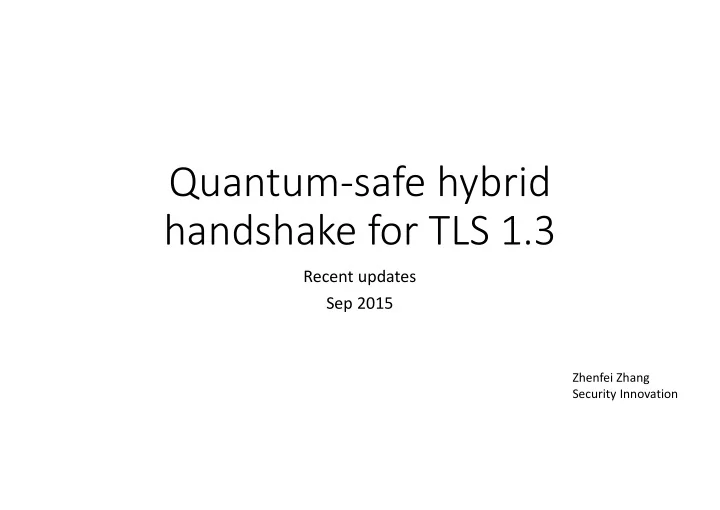

Quantum-safe hybrid handshake for TLS 1.3 Recent updates Sep 2015 Zhenfei Zhang Security Innovation
QSH_TLS Features � Run a classical key exchange as � Defeat the harvest-then-decrypt usual and obtain a classical pre- attack with low cost; master secret c ; � Modular design allows for trial � In parallel, transport another use of quantum-safe pre-master secret q using a key cryptography; encapsulation mechanism (KEM), � Requires one additional cipher instantiated with a quantum- suite identifier; safe (a.k.a post-quantum) � It would be nicer if no identifier is encryption algorithm; added. � The final master secret will be derived from KDF( c | q )
QSH_TLS The story so far � Run a classical key exchange as � At IETF 93, William Whyte usual and obtain a classical pre- presented the Quantum-Safe master secret c ; Hybrid (QSH) hand shake for TLS 1.3 � In parallel, transport another � No objections to continuing to pre-master secret q using a key encapsulation mechanism (KEM), investigate this approach within instantiated with a quantum- TLS but defer to CFRG on safe (a.k.a post-quantum) algorithm selection encryption algorithm; � CFRG hummed unanimously to � The final master secret will be pursue further investigations of derived from KDF( c | q ) quantum-safe crypto
Updates #0 (Global): QS crypto � There is a growing concern on quantum safety in the past few months: � NSA has advised people to move away from ECC and announced their plan to migrate to quantum-safe cryptography; � https://www.nsa.gov/ia/programs/suiteb_cryptography/ � The EU has expressed in their Horizon 2020 project a desire for systems to be "quantum- ready" by 2020; � http://pqcrypto.eu.org/slides/20150403.pdf � Google have optimistically predicted practical and powerful quantum computer could become available by the 2020 to 2025. � http://www.theplatform.net/2015/07/22/google-sees-long-expensive-road-ahead-for-quantum- computing/ � More is coming…
Updates #1 (CFRG): algorithm selection � We have an internet-draft describing the selection criteria of quantum-safe encryption algorithm to be adopted in the QSH_TLS � The idea is to � setup a base line for QS encryption schemes; � provide a list of existing QS encryption schemes meeting those criteria; � allows a clear pathway to adoption for future QS schemes. � CFRG is currently reviewing this document � (Most of) our initial recommendations align with PQCRYPTO’s initial recommendations and ETSI ISG-QSC’s recommendations � http://pqcrypto.eu.org/docs/initial-recommendations.pdf
Updates #2 (TLS): Cipher Suite -> Extension � We move QSH_TLS data from KeyShare message to HelloExtension and HelloRetryRequestExtension � Following on comments from DKG and others at Prague meeting � We require an extra ExtensionType, rather than a cipher suite identifier � The latest version: � https://www.ietf.org/internet-drafts/draft-whyte-qsh-tls13-01.txt � Change made only in TLS 1.3 version of spec, can be propagated into TLS 1.2 version if useful � TLS 1.2 version still uses Cipher Suite approach
Updates #3: Performance analysis � Feedback from ETSI ISG-QSC group Classical Time � An additional KEM is likely to strength increase the cost NTRU449 encryption 128 bits 2 � Latency, not significantly. NTRU743 encryption 256 bits 4.4 � See table on the right RSA2048 decryption 112 bits 100 � Handshake packet size, may be affected: need a much larger curve25519 DH 128 bits 3.4 extension field � See next slide Relative cost on server side Benchmark from SUPERCOP � The KDF is not going to add extra http://bench.cr.yp.to/supercop.html cost � Previous we do KDF(c) � Now we do KDF(c|q)
Obstacles #1 � Extension field is limited to 2^16-1 bytes � This would forbid the use of QS encryption schemes with key/cipher size > 65KB � lattice-based crypto are okay, including NTRUEncrypt, R-LWE, etc; � code-based crypto are not, including McEliece, McBits, etc; � Those keys/ciphertexts are on the order of MB � We had similar issue with Tor cell size – get away with a “multi cell” solution; � This does not work for TLS 1.3 � There's also an explicit MUST NOT clause for passing multiple extension fields of the same type. � Proposal: Consider increasing the size limitation on extension fields to, say 2^24-1 byte?
Obstacles #2 � Extension field of KeyShare message is Client Server encrypted ClientHello ClientHelloExtension � We could in principle encrypt QSH_TLS (QS Public Key) --------> ServerKeyShare message, but that would be redundant EncryptedExtension (QSHCipherList) � The actual data in the QSH_TLS message <-------- {Finished} is a ciphertext of the QS scheme {Finished} --------> � We would request QSH_TLS message to ClassicSecret|QSHSecret <-------> ClassicSecret|QSHSecret be on the non-encrypt whitelist � If TLS WG choose to go along with the whitelist method
Actions � Extension size limitation? � Whitelist? � To get the individual draft adopted as a WG draft � The approach is so modular that it doesn’t rely on any QS scheme � So we should start working on this draft while CFRG is still considering QS candidates
Recommend
More recommend